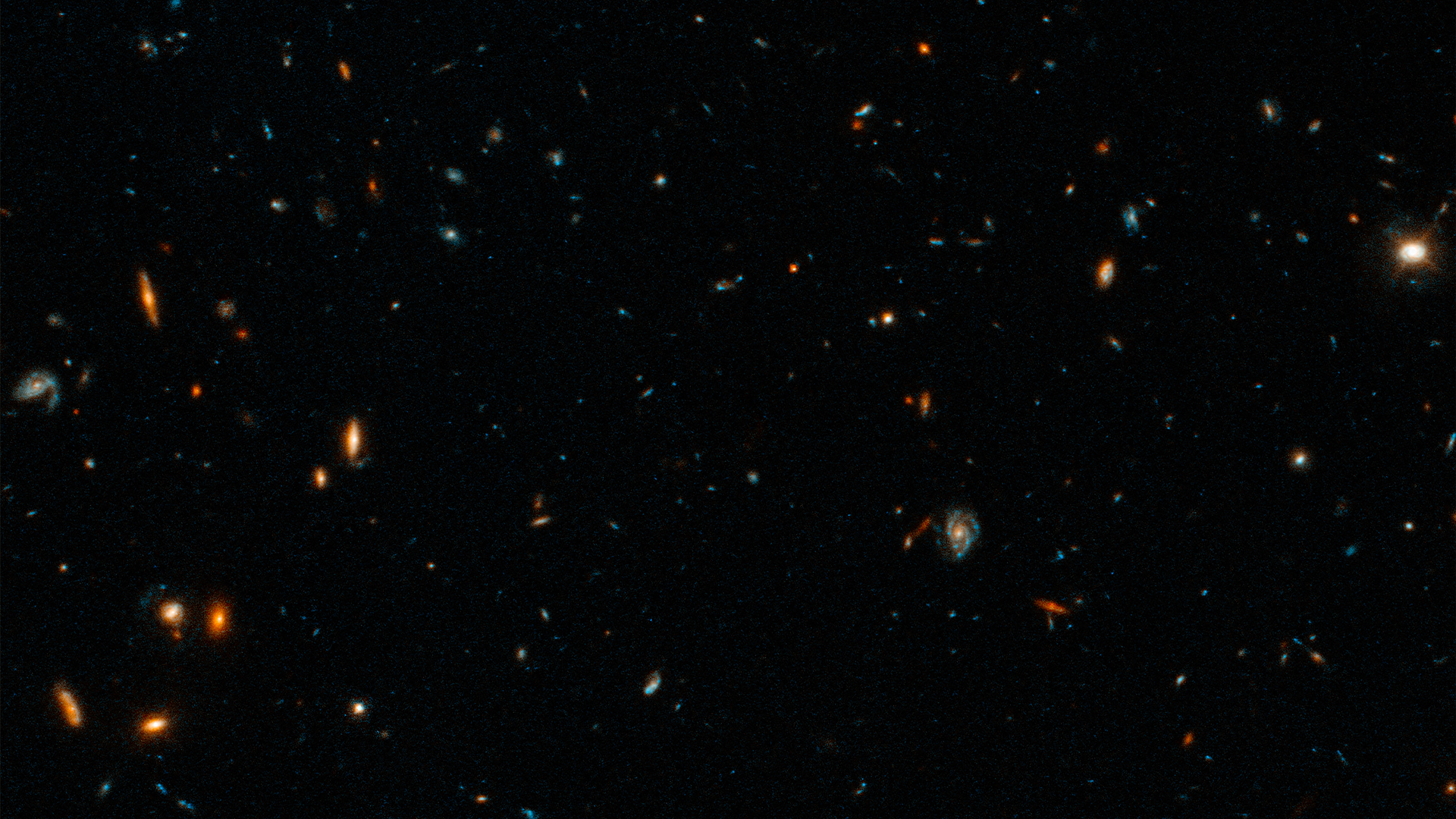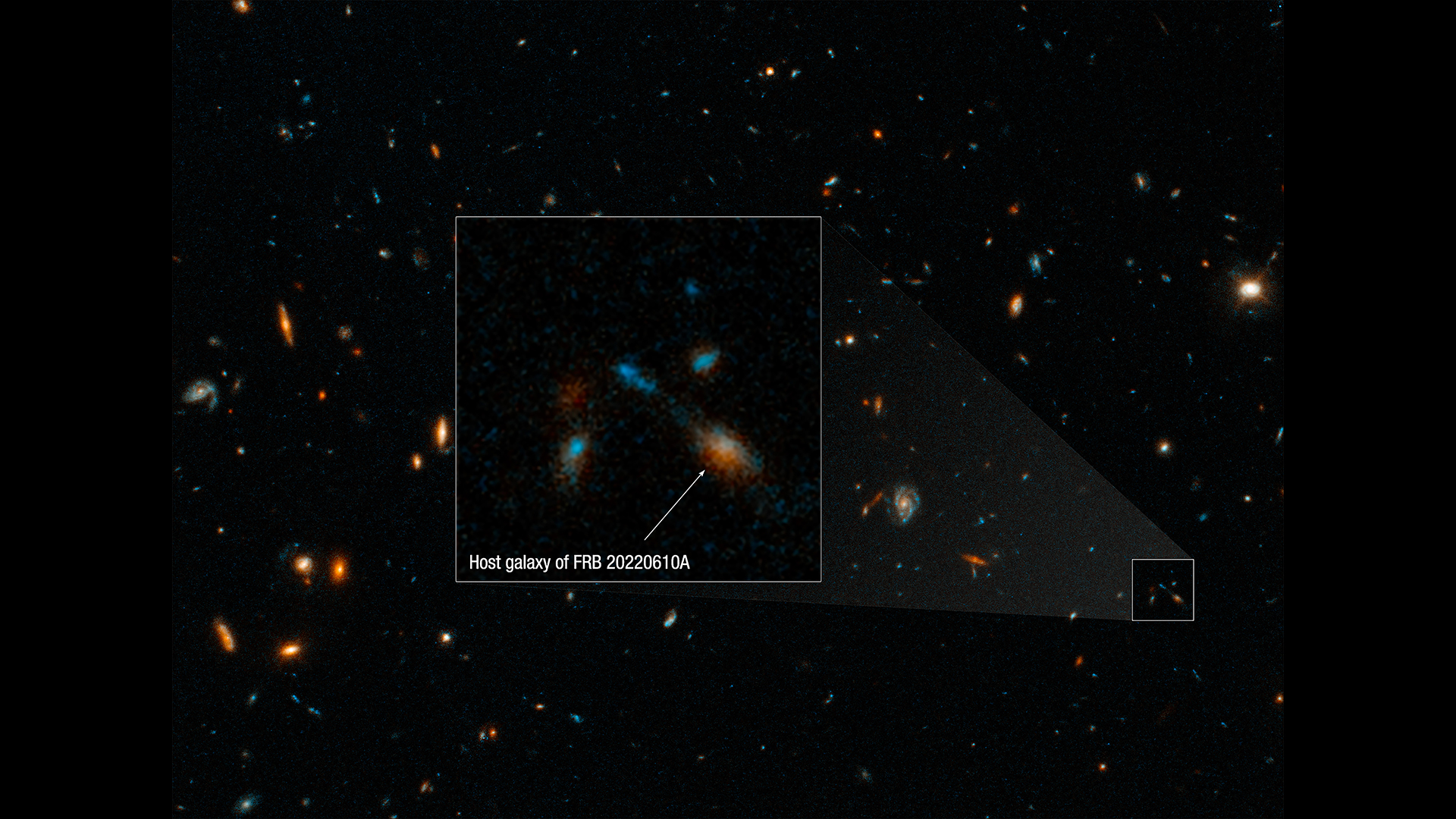
The Hubble Space Telescope has tracked the most powerful and farthest burst of radio waves ever seen back to a surprising source: a "blob" of seven galaxies, some of which may be merging.
The galactic gathering launched out this fast radio burst (FRB) — which in a millisecond released the equivalent of our sun's total emission over 30 years — when the universe was just 5 billion years old.
When astronomers first spotted the radio burst, known as FRB 20220610A, in 2022, they tracked the burst back to a shapeless blob they thought was an irregular galaxy or maybe three closely grouped galaxies. Now, researchers have used the incredible resolving power of Hubble to discover the true nature of this blob.
Related: Scientists detect fastest-ever fast radio bursts, lasting just 10 millionths of a second
"Without the Hubble's imaging, it would still remain a mystery as to whether this FRB originated from one monolithic galaxy or from some type of interacting system," study leader Alexa Gordon, a scientist at Northwestern University, said in a statement. "It's these types of environments — these weird ones — that drive us toward a better understanding of the mystery of FRBs."
The team's findings, which Gordon presented at the 243rd meeting of the American Astronomical Society in New Orleans, Louisiana, on Tuesday (Jan. 9), could challenge current theories of what objects and events can generate FRBs.

What do we know about the galaxies that launched FRB 20220610A?
The seven galaxies that launched the FRB are extremely tightly bound and so closely jammed together that they could fit within the Milky Way. At this proximity, they are likely influencing each other.
"There are some signs that the group members are 'interacting,'" study co-author Wen-fai Fong, also of Northwestern University, said in the statement. "In other words, they could be trading materials or possibly on a path to merging. These groups of galaxies (called compact groups) are incredibly rare environments in the universe and are the densest galaxy-scale structures we know of."
The interactions between the galaxies could be triggering bouts of extreme star formation within them, Gordon said, which may indicate that the source of FRB 20220610A is tied to a population of newborn stars. The connection between FRBs and nurseries of stellar infants is something that has been suggested in the past, she added.
Tracking an FRB back to its home is no mean feat. Though around 1,000 FRBs have been observed, very few have actually been traced to a source. "Within that small fraction, only a few came from a dense galactic environment, but none have ever been seen in such a compact group," study co-author Yuxin (Vic) Dong, an astronomer at Northwestern, said in the statement. "So, its birthplace is truly rare."
Researchers can't identify the cause of most FRBs, but many astronomers think they are launched by highly dense compact objects such as neutron stars or black holes.
Understanding the source and cause of FRBs could also be key to unlocking deeper secrets of the cosmos. Because these bursts of radiation traverse billions of light-years to reach us, the objects they pass through and the expansion of the universe alter the radio waves.
"Radio waves, in particular, are sensitive to any intervening material along the line of sight — from the FRB location to us," Fong said. "That means the waves have to travel through any cloud of material around the FRB site, through its host galaxy, across the universe, and finally through the Milky Way. From a time delay in the FRB signal itself, we can measure the sum of all of these contributions."
This makes FRBs a useful cosmic messenger encoded with information about the universe, but they can only be read effectively if astronomers understand what they looked like when they left their home galaxies. To decode FRBs, astronomers need to capture more of these events. Gordon said the technology needed to capture much fainter FRBs is just around the corner.
"In the near future, FRB experiments will increase their sensitivity, leading to an unprecedented rate in the number of FRBs detected at these distances," Gordon said.
For instance, the International Square Kilometre Array, two radio telescopes under construction in South Africa and Australia, should be able to spot thousands of FRBs too faint to be seen with current instruments.
"Astronomers will soon learn just how special the environment of this FRB was."







